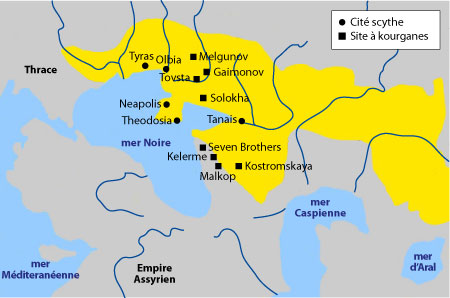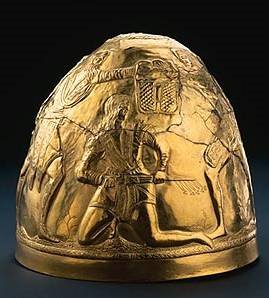This is the story of Ateas, king of the Scythians, rough nomad who would have unified all Scythia from the Danube to the Don.
Contents
ToggleAteas king of the Scythians
The last phase of the politico-military history of European Scythia is linked to the character of Ateas (died 339 BC), whose long reign in the 4th century BC. AD was marked by a final attempt to expand westward. Some aspects of it are known to us thanks to texts by Strabo, Polyen, Trogue Pompée and Clement of Alexandria.
The character himself is introduced to us by the sources greek as a powerful sovereign, who would have unified all of Scythia from the Danube to the Don (Strabo, VII, 3,18), but who remained a typical nomad in his roughness and barbarism.
We can also suspect the writers greeks to have accentuated this aspect within the framework of the confrontation between Scythians and Macedonians, but also the king himself to have deliberately "played at the Scythian", as later Attila would "play at the Hun", to inspire fear if not the respect.
Reported by Plutarch, a famous anecdote - because it corresponds exactly to the opinion of the classical world - shows him being given a private concert by Isménias, a famous Greek flautist prisoner, before grumbling that he preferred the neighing of his horses.
The ambassadors of Philip II of Macedonia (however considered him also as a "barbarian" by the Athenians!) Were taken aback to hear themselves ask, by Atéas who received them while brushing his horses, if their master also took care personally of the horses. his. And the letter from the Scythian king to the inhabitants of Byzantium, threatening them to come and give his horses to drink in the Bosporus, belongs to a literary genre which will be widely practiced by the great nomadic warlords of the following eras - here again we think of Attila.

The territory of the Scythians
Music lover or not, Atéas harbored ambitious projects heading west. There is certainly a link with pressure from Sarmatians east of Scythia, but it is difficult to say in what direction: was it this pressure that prompted Ateas to seek compensation in the Danubian regions, or on the contrary his Western tropism - and the final failure of his projects? – which allowed the Sarmatians to infiltrate west of the Don?
In any case, from the third quarter of the fourth century BC. AD, the presence of the Sarmatians is attested by archaeological remains between Don and Donets, and there are traces of early infiltration west of the Donets. In the second half of this 4th century BC. AD, the Pseudo-Scylax still locates the Sauromates east of the Don, but also knows “Syrmates” further west, on the shore of the Sea of Azov.
Without knowing all the details of the policy led by Atéas, we know that he established around the middle of the 4th century BC. J.-C a head of Scythian point on the right (southern) bank of the Danube, in the present day Dobroudja, that he made war on the Triballi and imposed tribute on part of the Thracians. In fact, he apparently aimed at building up a Danubian Scytho-Thracian power. His ambitions in the region soon led to a confrontation with the powerful King of Macedonia, Philip II.
Philip II decisively defeated the Scythians in 339
Philippe, who had married a daughter of Ateas, seems at first to have cherished the hope of being recognized as heir to the old Scythian sovereign; the latter would have made him answer that he himself had a son. He then announced that he intended to come - with, as one can imagine, a strong escort - to erect a statue of Herakles at the mouths of the Danube. This rather crude ruse angered Ateas even more, who volunteered to set up the statue and threatened, if it was brought into Scythia without his consent, to melt it down to make arrowheads (an additional touch to his self-portrait in " Barbaric " ?).
In 339 BC. AD, Scythians and Macedonians clashed on the Danube, in a decisive battle of which we unfortunately do not know the exact location and course. We only know that Philippe, who had staked everything on his victory, had placed his best riders at the rear of his troops with the order to shoot down all those who tried to fall back.
The fight was certainly very violent: Philippe was nailed to his horse by a lance which crossed his thigh, and limped the rest of his life, but Atéas was killed (he was then 90 years old) and the Scythians defeated. The Macedonians seized an enormous booty - Philippe sent 20,000 mares to his stud farms - part of which was taken from them by hostile tribes on the way back.
This battle made Macedonia the dominant power in the region, and their defeat certainly dealt a significant blow to the prestige of the Scythians.
In 331, heavy defeat of the Macedonians before the Scythians at the siege of Olbia

After the death of Ateas, the Getae tribes crossed over to the left bank of the Danube, and perhaps advanced as far as the Dniester. Scythian burials are however still attested in the second half and until the end of the 4th century BC. AD between Prout and Dniester. In addition, Scythian military power was not destroyed.
The Macedonians had this bitter experience in 331 BC. AD, barely eight years after their great victory over Atéas. Zopyrion, who ruled Thrace on behalf of Alexander the Great, entered Scythia and besieged the city of Olbia, an ally of the Scythians. These came to unblock the city.
During the battle, Zopyrion was killed and his entire army wiped out. It was one of the rare defeats of the entire reign of Alexander the Great, and we regret all the more not to have any record of the fighting. It would be interesting to know how a confrontation could unfold between the Macedonian phalanx, which had reached its perfection, and the horsemen of the steppes - certainly supported, at that time, by a not insignificant infantry (cf. chap. VIII).
Without completely erasing the effects of the defeat of 339 BC. AD, this victory of Olbia shows that the Macedonians were not the main cause of the Scythian decline, which is undoubtedly more linked to the parallel expansion of the Sarmatians east of the Ukrainian steppes.